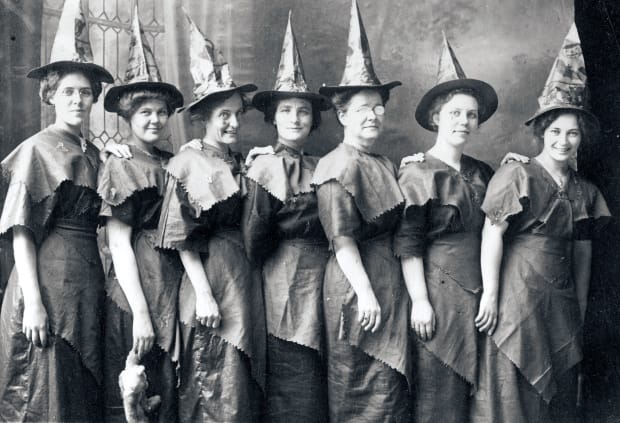Spiders, Ghosts, and Ghouls — Oh My!
The origin of Halloween and its history throughout time.
October 24, 2022
Many people regard Halloween as a holiday simply to indulge in scary things, dress up and go from door to door for candy, or perhaps even play a prank or two. Although many participate in the holiday, its rich history remains widely unknown. However, Halloween dates back almost a thousand years and, despite its controversy, it has lived on as a widely celebrated holiday for its culture, history and traditions.
1200 BC – 43 AD
A Very Spooky Start
Fear and skepticism are companions to the unknown, and as the nights’ darkness started to lurk more openly across the Western European lands, and a sense of unease came across the Celtic people.
Samhain, pronounced ‘sow-in’, was the festival celebrating the transition into darker hours and marked the beginning of the harvest for the Celtic people. This transmutation was considered sacred, as the Celts drew semblance between the shifting seasons and the passage of life. Samhain was considered a night when spirits could roam around the Earth, causing whatever havoc they so desired before they made their journey to the afterlife.
There were, of course, traditions that embodied this belief. The Celts would dress up in animal skins to blend in with the ‘wretched ones’, light bonfires to help guide them to the afterlife, and even leave food out to appease the spirits. The Druid Priests would light the bonfires that were made to represent the sun to ensure it would come back again in the following seasons. These priests also told fortunes, while making sacrifices to the gods, this was called ‘samghnagans’.
Fun Fact: Since the Celts would make sacrifices and throw bones into the fire, the term ‘bon fire’ got coined from it, which later became abbreviated into what we know today: bonfire!
43 AD – 800
The Villains of the Story, But It’s Just Christians Again:
The Celts had continued to celebrate Samhain for hundreds of years until the Romans conquered the British Islands in 43 A.D. This infusion of people with different cultural and religious beliefs didn’t hinder the tradition of Samhain but instead elevated it and enhanced the general idea behind the ancient tradition. The Romans have a deep, rich history, and Feralia was a holiday celebrated by them which honored the dead. There were also celebrations for the acclaimed Pomona the Roman goddess of the harvest and fruit. This accumulation of costumes helped to amalgamate to what we now consider modern Halloween.
But, all good things must come to an end, right? Eventually the Roman empire fell which paved the way for the Christians, who were gradually colonizing the West, to take over the Celtic territory.
Catholic religious and purity ideology caused Celtic culture to take a heavy blow. It wasn’t their goal to wipe out Celtic culture, however, but to instead convert it into something they could agree with, as such was the philosophy of Pope Gregory I. This led to them putting Christian holidays near or on Celtic festivals to help make the assimilation into Catholicism smoother. However, when that didn’t eliminate their beliefs they started to ostracize the Celtics/Pagan people, saying their traditions were evil and of the devil.
Around the 800s, Nov. 1 was labeled All Saints’ Day and was used to celebrate various christian figures. It was hoped that this would terminate Samhain once and for all, but people still continued to practice by simply celebrating it a day early on Oct. 31. The Catholics once again tried to eradicate the pagan holiday by extending All Saints’ Day from Oct. 31 to Nov. 2 and calling it All Souls Day, which followed the same principle but also included many of the Samhain traditions, bonfires, feasts, and dressing up!
Fun Fact: Poor families would go door to door and offer prayers in exchange for soul cakes. This was called “souling.” Is this sounding familiar? To further institute how sacred All Saints’ Day was, it earned the name All Hallows. Therefore, Samhain became Hallows Eve, which later got abbreviated into the term ‘Hallowe’en’.
800 – Now
Halloween in America:
For a while, the traditions of Halloween were just strictly in Europe. However, Irish people seeking refuge from the Irish Potato Famine migrated to America and brought many of their customs with them. At first, this was a novelty to the very nativist Americans who were less than thrilled to have foreigners in the United States. But through watching them express their traditions, many started to gradually join in on the bandwagon.
The festival caught on fast, and by the 20th century many started to add on their own customs and ideas to the ancient tradition. The term ‘trick or treat’ didn’t catch on until 1951 when a Disney short film depicted Donald Duck and his relatives engaging in Halloween activities titled ‘Trick or Treat’.
Today, most people, especially Americans, don’t celebrate Halloween for its traditional values and instead use it as an excuse to get friends together and watch horror movies. But, nevertheless, its legacy lives on as a highly commended and sacred holiday that has survived trial and tribulation. And even as everyone dresses up as their favorite heroes and goes door to door, the ghosts of Halloween’s history will continue to stir up excitement in all the hearts of those who participate.
Facts were provided by: History Channel & Gale

